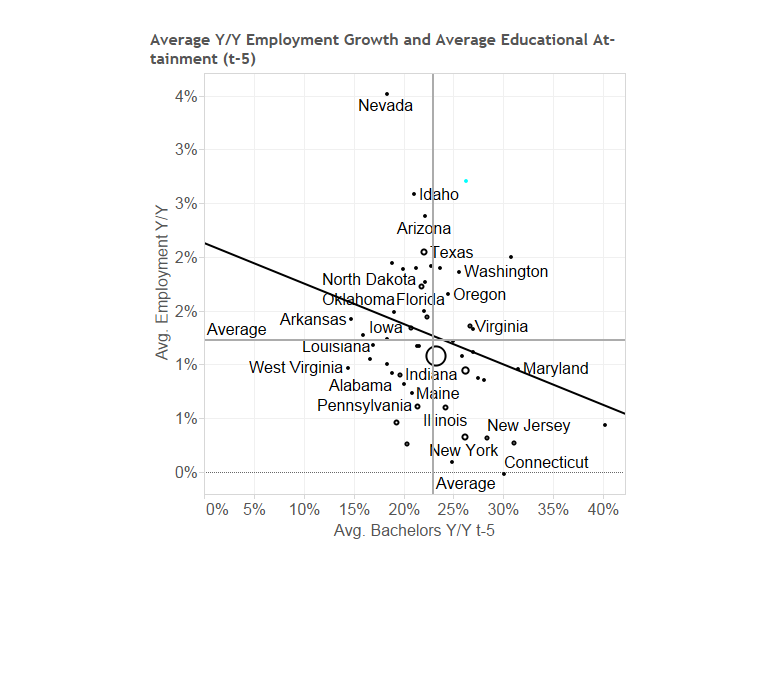Fiscal Highlights - May 2014
|
Is there a Relationship between Educational Attainment and Employment Growth? -
Thomas E. Young ( The Education Interim Committee heard presentations on long-term planning for educational attainment. As background, the following is what the relationship is between the percentage of the population with a Bachelors degree or higher and employment growth. Overall, the relationship is negative over all years. The negative correlation simply means that states where a higher percentage of the population has a Bachelors degree generally experience slower employment growth. The linear result would imply that, for example, if the percentage of individuals with a Bachelors degree in Utah went from say 33% to 40%, the anticipated average growth rate would decline from say 3.2% to 2.5%.
Here's how the relationship has changed across time in animated GIF format. Overall, the relationship is always negative, and has become weaker over time. In general, in years of economic growth, employment growth is faster in areas with lower educational attainment numbers, while in recession years, employment growth is higher in areas with higher educational attainment.
The result might be due to the lagged effect education may have on employment. The following static picture averaged across all years and animated GIF do not confirm any lagged effects when looking at a five-year period.
The result that a more highly educated workforce generally experiences slower employment growth may be due to wage pressure (states with higher average wages generally grow slower), differences in the industry makeup within each state, the shifting of earning potential out more years, and other factors. In any event, places where educational attainment is more prevalent generally experience lower employment growth. |
$107 Million of Excess Federal TANF Spending Authority - Stephen C. Jardine The Department of Workforce Services (DWS) administers the federal Temporary Assistance for Needy F...Division of Air Quality: New Appropriations Update - Angela J. Oh Air quality was a priority during the 2014 General Session. Lawmakers passed legislation to cut emi...DJJS - Receiving Centers and Youth Services - Zackery N. King What is the next step for receiving centers and youth services? Receiving centers and youth s...Economic Development Incentives - Andrea Wilko Financial incentives are provided through the Utah Governor's Office of Economic Development and th...Higher Education Tuition Increases for 2014-2015 - Spencer C. Pratt Following the 2014 General Session, the State Board of Regents met and approved a 4.0% first-tier t...How Will Quagga Mussel Impact Utah Financially? - Ivan D. Djambov Now that the invasive quagga mussels are established in Lake Powell, how long before they get to ot...Is there a Relationship between Educational Attainment and Employment Growth? - Thomas E. Young The Education Interim Committee heard presentations on long-term planning for educational attainmen...Jail Reimbursement Program and Appropriations - Fiscal Years 2011-15 - Gary K. Ricks The Jail Reimbursement Program provides reimbursement to Utah counties for days spent in county jai...Medicaid and CHIP Enrollment Trends Since the Beginning of Mandatory Medicaid Expansion - Russell T. Frandsen Since the beginning of the Medicaid mandatory expansion as part of federal health care reform in Ja...Sequestration Update - Steven M. Allred In December 2013, Congress passed the Bipartisan Budget Act of 2013 (BBA), providing states some ce...The Billion Dollar Retirement Gap - Brian D. Fay In 2008, the Utah Retirement System (URS) experienced investment losses of nearly 25 percent, leavi... |
Reports/Archive | Budget Process | Office Background | Who's Who | Organization Chart
Office of the Legislative
Fiscal Analyst
House Building, Suite W310
Salt Lake City, UT 84114
Phone (801) 538-1034 Fax (801) 538-1692



